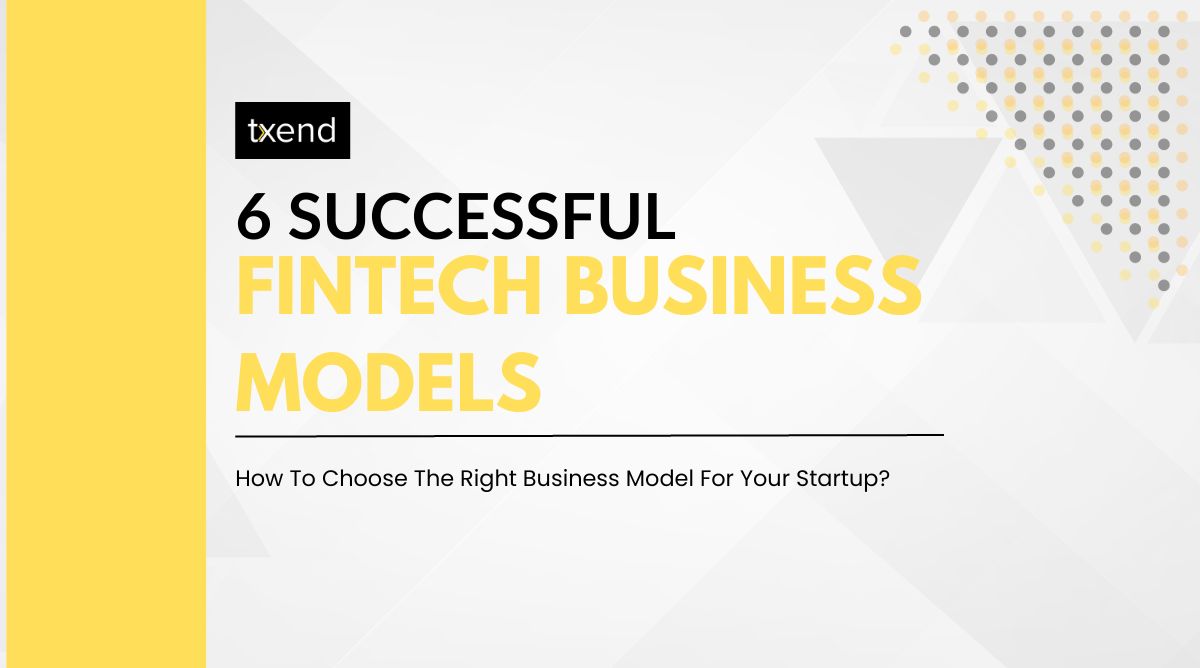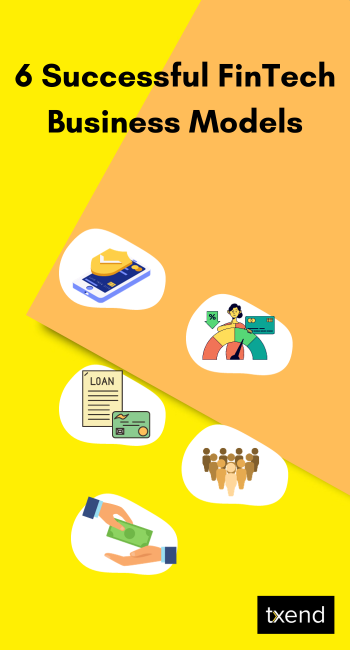
In the ever-evolving landscape of financial technology, understanding the intricacies of fintech business models is paramount. Fintech companies are not just revolutionizing the way we manage our finances; they’re also reshaping the traditional paradigms of how businesses generate revenue.
In the US market, where fintech innovation is thriving, comprehending the business model of fintech companies and how fintech makes money is essential for investors, entrepreneurs, and consumers alike.

This essay goes deeply into the idea of a fintech business model, illuminating the methods used by these forward-thinking businesses to succeed in the financial industry. We will explore real-world fintech business model examples that have disrupted traditional finance and paved the way for a more digital and accessible financial future.
Join us on this exploration of fintech business models in the dynamic US market, and uncover the secrets behind how fintech companies not only survive but thrive in an era of unprecedented technological advancement and financial transformation.
Whether you’re a fintech enthusiast, an aspiring entrepreneur, or simply curious about the future of finance, this article will provide valuable insights into the fascinating world of fintech business models and how they are reshaping the financial industry.
Key Takeaways
- A fintech business model outlines how a financial technology company generates revenue, often through innovative digital services and products.
- Prominent fintech business models include digital banking, alternative credit scoring, unbundling, small ticket loans, demographic-focused products, and different fee structures.
- Factors determining a suitable startup business model include market research, customer needs, technology, regulation, revenue strategy, user experience, and scalability.
Fintech Business Model
A Fintech business model refers to the strategic framework and approach that financial technology companies adopt to create, deliver, and capture value in the financial industry.
It encompasses how fintech companies generate revenue, sustain profitability, and disrupt traditional financial services.
Fintech business models leverage technology, innovative services, and data-driven approaches to offer a wide range of financial products and solutions, from mobile payments and peer-to-peer lending to robo-advisory services and blockchain-based platforms.
These models often focus on enhancing customer experiences, reducing costs, and providing financial services that are more accessible and convenient.
Value Proposition:
What unique financial services or solutions does the fintech offer to address customer needs or pain points?
Customer Segments:
Who are the target customers or user groups, and what are their specific financial needs and preferences?
Distribution Channels:
How does the fintech company reach and engage with customers? This may involve mobile apps, websites, partnerships, or other distribution channels.
Revenue Streams:
How does the fintech make money? This could be through subscription fees, transaction fees, commissions, data monetization, or other revenue sources.
Cost Structure:
What are the key costs associated with operating the fintech business, including technology, marketing, and regulatory compliance?
Key Partnerships:
Are there strategic partnerships or collaborations with other businesses, banks, or financial institutions that contribute to the business model’s success?
Investors, business owners, and other industry experts must comprehend the complexities of a fintech business model in order to successfully traverse the ever changing financial technology world. It’s about deciphering the innovative strategies that enable fintech companies to thrive in the digital age and disrupt traditional financial services.
6 Successful FinTech Business Models

Digital Banking:
Digital banking is one of the most prominent fintech business models in the US. It involves offering banking services entirely online or through mobile applications.
Fintech companies in this space typically provide services like savings accounts, checking accounts, payment processing, and even investment opportunities without the need for traditional brick-and-mortar banks. Examples include Chime and Ally Bank.
Pros
- Convenience: Digital banking offers 24/7 access to financial services, allowing customers to manage their money and make transactions at their convenience.
- Lower Fees: Many digital banks have lower fees or no fees for basic services, making them cost-effective compared to traditional banks.
- Enhanced User Experience: User-friendly mobile apps and websites provide a seamless and intuitive banking experience.
- Financial Inclusion: Digital banking can reach underserved populations who have limited access to physical bank branches.
Cons
- Security Concerns: Online banking may be vulnerable to cybersecurity threats and fraud, raising concerns about the safety of personal and financial data.
- Limited Physical Presence: Lack of physical branches can be a drawback for customers who prefer face-to-face interactions or need in-person services.
Alternative Credit Scoring:
Fintech companies in the alternative credit scoring space leverage innovative data sources and algorithms to assess creditworthiness beyond traditional credit scores.
They may consider factors like a person’s social media activity, online shopping habits, and utility bill payments to provide credit to individuals who may have limited or no credit history.
This model expands access to credit for underserved populations. Examples include Upstart and Experian’s Boost.
Pros
- Expanded Access to Credit: This model allows individuals with thin or no credit histories to access credit, promoting financial inclusion.
- Fairer Assessments: It can provide a more holistic and fair evaluation of creditworthiness by considering non-traditional data points.
- Lower Interest Rates: Some alternative lenders offer lower interest rates compared to predatory lending options like payday loans.
Cons
- Data Privacy Concerns: Gathering alternative data can raise privacy concerns, and the misuse of sensitive data can be detrimental.
- Risk Assessment Challenges: Developing accurate risk assessment models using alternative data can be complex and prone to errors.
Unbundling:
Unbundling involves breaking down traditional financial services into specialized, standalone products or services. Fintech companies focus on offering specific financial solutions, such as investment management, insurance, or peer-to-peer lending, rather than providing a one-stop-shop for all financial needs.
This allows consumers to choose and customize their financial services. An example is Robinhood, which focuses on stock trading.
Pros
- Customization: Consumers can select and use only the financial services they need, tailoring their financial experience.
- Specialization: Fintech companies can excel in specific niches, providing high-quality services in areas like investment or insurance.
- Competition: Unbundling fosters competition, potentially leading to better services and lower costs for consumers.
Cons
- Fragmented Experience: Using multiple fintech services may result in a fragmented financial experience, requiring users to manage multiple accounts and apps.
- Over choice: Too many options can overwhelm consumers, making it challenging to choose the right services for their needs.
Small Ticket Loans:
Small ticket loans fintech business model caters to the need for small, short-term loans that traditional banks often overlook.
These loans are usually quick to access and repay, making them suitable for emergency expenses. Fintech companies in this space provide microloans, payday loans, or cash advance services.
An example is LendingClub, which offers personal loans.
Pros
- Quick Access: Small loans offer quick access to funds for emergencies or short-term needs.
- Flexibility: Borrowers can repay these loans over a short period, avoiding long-term debt commitments.
- Financial Inclusion: Small ticket loans can serve individuals with limited access to traditional credit sources.
Cons
- High-Interest Rates: Some small ticket loans come with high-interest rates, making them costly for borrowers if not managed properly.
- Debt Trap: There is a risk of borrowers falling into a cycle of borrowing if they cannot repay the loan on time.
Demographic-Focused Products:
Some fintech companies target specific demographic groups or niche markets with tailored financial products.
These products cater to the unique financial needs and preferences of these demographics. For instance, some fintech startups focus on providing financial solutions for millennials, retirees, or specific ethnic communities, addressing their specific pain points.
Pros
- Tailored Solutions: Focusing on specific demographics allows fintech companies to offer products that cater to unique needs and preferences.
- Market Niche: It may result in a devoted consumer base and less rivalry in niche areas.
Cons
- Limited Market Size: Serving a narrow demographic may limit the potential customer base and growth opportunities.
- Risk of Stereotyping: There’s a risk of unintentionally stereotyping or excluding certain groups if not approached carefully.
Different Fee Structures:
Fintech companies often employ innovative fee structures that differ from traditional banks.
They may offer lower fees or even fee-free services for basic banking transactions while generating revenue through other means, such as referral fees, premium services, or partnerships with other companies. PayPal, for instance, generates revenue from merchant processing fees and currency conversion fees.
Pros
- Cost Savings: Consumers can save money with lower or no fees for basic services.
- Transparency: Some fee structures are more transparent, making it easier for consumers to understand costs.
- Revenue Diversification: Fintech companies can explore various revenue streams, reducing reliance on traditional banking fees.
Cons
- Complexity: Non-traditional fee structures can be complex, and consumers may find it challenging to understand the true cost of services.
- Hidden Fees: Some fintech companies may still have hidden fees or charges that are not immediately apparent to customers.
These prominent fintech business models in the US represent the diversity and innovation in the financial technology sector. They aim to provide consumers with more accessible, affordable, and customizable financial services, disrupting traditional banking models along the way.
How To Choose The Right Business Model For Your Startup?
When determining a suitable business model for a fintech startup targeting the US market, several key factors come into play. Here are the factors to consider:

Market Research and Analysis:
Customer Needs and Pain Points:
Understand the specific financial needs and challenges of the US market. Identify gaps in existing services that your fintech startup can address.
Competitive Landscape:
Analyze the competition within the US fintech sector. Determine what other companies are offering, their strengths, weaknesses, and market positioning.
Regulatory Environment:
Be aware of the regulatory framework governing financial services in the US, as it can significantly impact your business model.
Target Customer Segments:
Demographics:
Define the target customer demographics within the US. Consider factors such as age, income level, and geographic location to tailor your services.
Customer Behavior:
Understand how potential customers prefer to manage their finances and make payments. This can influence the features and delivery channels of your fintech product.
Value Proposition:
- Clearly articulate the unique value your fintech startup brings to the US market. What problems will you solve, and how will you make customers’ financial lives better?
- Determine if your value proposition is aligned with the US market’s needs and preferences.
Technology Stack:
- Assess the technology infrastructure required to support your business model. Determine whether you need partnerships, data analytics, blockchain, or other technology components.
- Consider scalability and flexibility to adapt to changing market demands.
Revenue Generation:
- Explore various revenue models, such as subscription fees, transaction fees, advertising, partnerships, or data monetization. Choose a model that aligns with your value proposition and target audience.
- Ensure your revenue model complies with US regulations and does not create pricing barriers for potential customers.
User Experience:
- Design a user-friendly interface and seamless customer journey. The ease of use can significantly impact user adoption and retention.
- Consider mobile accessibility, as mobile banking and payments are prevalent in the US.
Security and Trust:
- Develop robust security measures to protect customer data and financial transactions. Gain the trust of users by demonstrating a commitment to data privacy and cybersecurity.
- It is crucial to adhere to applicable industry norms and laws.
Scalability and Growth Strategy:
- Plan for scalability from the outset. Consider how you will expand your user base, services, and geographic reach over time.
- Define a clear growth strategy, including marketing and user acquisition tactics.
Regulatory Compliance:
- Ensure that your business model complies with US financial regulations, including licensing requirements and consumer protection laws.
- Keep abreast on legislative developments that may affect your business.
Funding and Financial Sustainability:
- Establish the finance requirements for your firm and look into several sources of funding, such as crowdfunding, angel investing, and venture capital.
- Establish a financial sustainability plan, including revenue projections and cost management strategies.
Partnerships and Ecosystem:
- Consider forming partnerships with other fintech companies, traditional financial institutions, or technology providers to enhance your offering and market reach.
- Leverage existing financial ecosystems to gain access to a broader customer base.
Feedback and Iteration:
- Be prepared to collect user feedback and iterate on your business model and product based on customer insights.
- Continuous improvement is key to staying competitive and meeting evolving customer needs.
Finally, picking the best business model for your fintech startup that is aiming for the US market necessitates having a firm grasp of the industry, a distinct value proposition, and careful consideration of technology, regulation, and user experience.
You may improve your chances of success in the dynamic and cutthroat fintech market by proactively tackling these issues.

Square:
Business Model:
Square provides payment processing solutions, hardware, and software for businesses. They make money by charging merchants a fee on each transaction.
Success Factors:
Square’s simple and accessible payment solutions, including the popular Square Reader, have made it a go-to choice for small businesses and entrepreneurs.
Stripe:
Business Model:
Stripe offers payment processing APIs that enable businesses to accept payments online. They charge a fee per transaction.
Success Factors:
Stripe’s developer-friendly platform, global reach, and robust features have made it a preferred choice for e-commerce and online businesses.
Robinhood:
Business Model:
Robinhood provides commission-free stock and cryptocurrency trading. They generate revenue through premium subscription services, order flow payments, and interest on customer deposits.
Success Factors:
Robinhood disrupted the brokerage industry by offering easy access to financial markets, particularly appealing to younger, tech-savvy users.
PayPal:
Business Model:
PayPal offers online payment processing, digital wallet services, and peer-to-peer money transfers. They make money from transaction fees, currency conversion, and interest on customer balances.
Success Factors:
PayPal’s widespread acceptance and integration with online merchants have made it a trusted and convenient payment solution.
Adyen:
Business Model:
Adyen provides a global payment platform for online, mobile, and in-store transactions. They charge fees based on transaction volume.
Success Factors:
Adyen’s single platform for multi-channel payments and its ability to handle complex international transactions have attracted large enterprise clients.
SoFi (Social Finance):
Business Model:
Student loan refinancing, personal loans, and investing services are just a few of the financial services that SoFi provides. They earn revenue through interest, loan origination fees, and investment management fees.
Success Factors:
SoFi’s holistic approach to personal finance and emphasis on financial education have resonated with millennials seeking alternative financial services.
Plaid:
Business Model:
Plaid provides APIs that connect fintech apps with users’ bank accounts. They charge fees to fintech companies for accessing bank data.
Success Factors:
Plaid’s infrastructure is critical for many fintech apps, making it a behind-the-scenes powerhouse in the financial technology ecosystem.
Affirm:
Business Model:
Affirm offers point-of-sale financing, allowing consumers to make purchases and pay over time with transparent installment plans. They generate revenue from interest and merchant fees.
Success Factors:
Affirm’s transparent and consumer-friendly approach to financing has gained popularity, particularly in the retail sector.
Coinbase:
Business Model:
On Coinbase, a cryptocurrency exchange, users may buy, sell, and trade cryptocurrencies. They earn fees from transactions and asset custody.
Success Factors:
Coinbase’s user-friendly interface and robust security measures have made it a trusted platform for cryptocurrency enthusiasts and investors.
These examples illustrate the diversity of fintech business models in the USA, ranging from payment processing to lending, investing, and cryptocurrency services. Each of these companies has found success by addressing specific needs in the financial services landscape and delivering innovative solutions to customers.
Frequently Asked Questions
Fintech is the future due to its innovation, improved accessibility, cost-effectiveness, and ability to meet evolving financial needs.
The four pillars of fintech include payments and transfers, lending, insurance, and asset management, shaping modern finance.
Five key fintech technologies: Blockchain, Artificial Intelligence, Mobile Apps, Cloud Computing, and Big Data analytics drive industry transformation.
With a recent global valuation of over $1 trillion, the fintech sector is worth billions of dollars.
Conclusion
In conclusion, understanding fintech business models is essential for anyone looking to navigate the dynamic financial technology landscape in the USA.
Fintech companies have revolutionized the way financial services are delivered and consumed, showcasing a diverse range of innovative approaches to generating revenue.
From payment processing pioneers like Square to disruptors in the investment space like Robinhood, these fintech business model examples demonstrate the adaptability and creativity of the industry. By exploring how fintech companies make money, we gain valuable insights into their strategies for success.
It’s important for both business owners and customers to keep knowledgeable about these business models as the fintech sector continues to develop and change the financial services environment in the USA.
Whether you’re considering launching a fintech startup or simply seeking to make informed financial decisions, a deeper understanding of fintech business models is a valuable asset in today’s tech-driven financial world.
